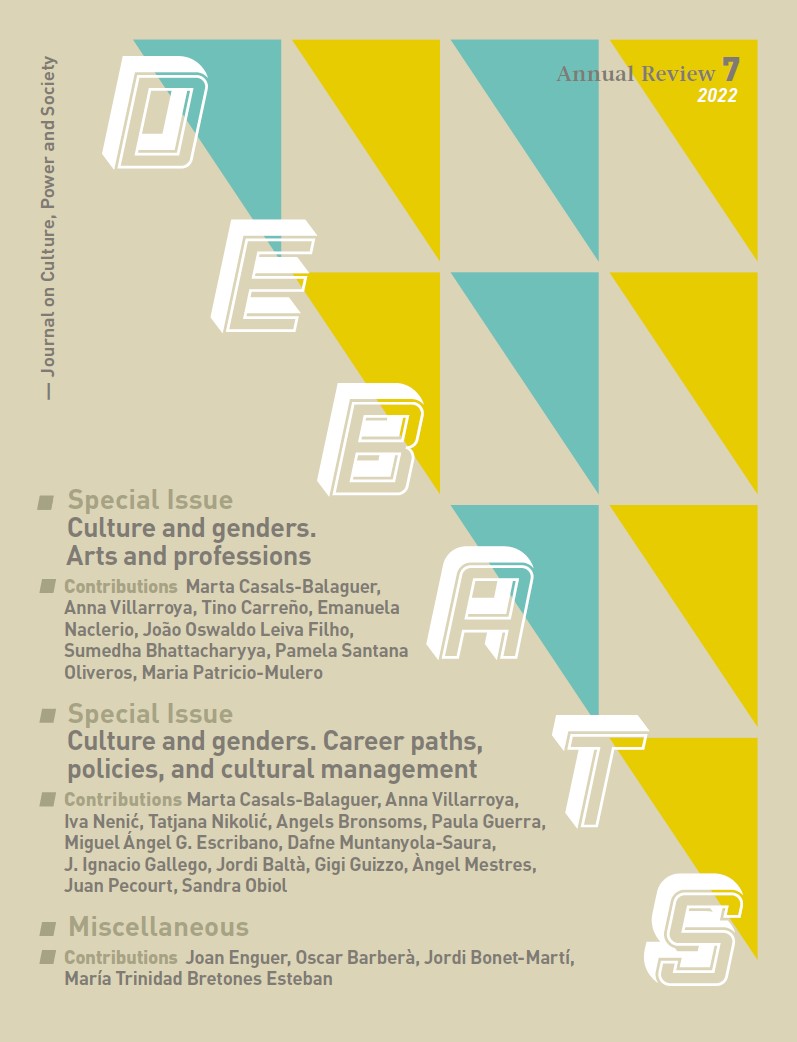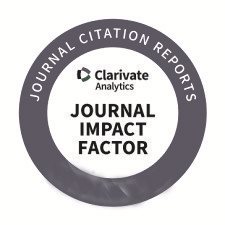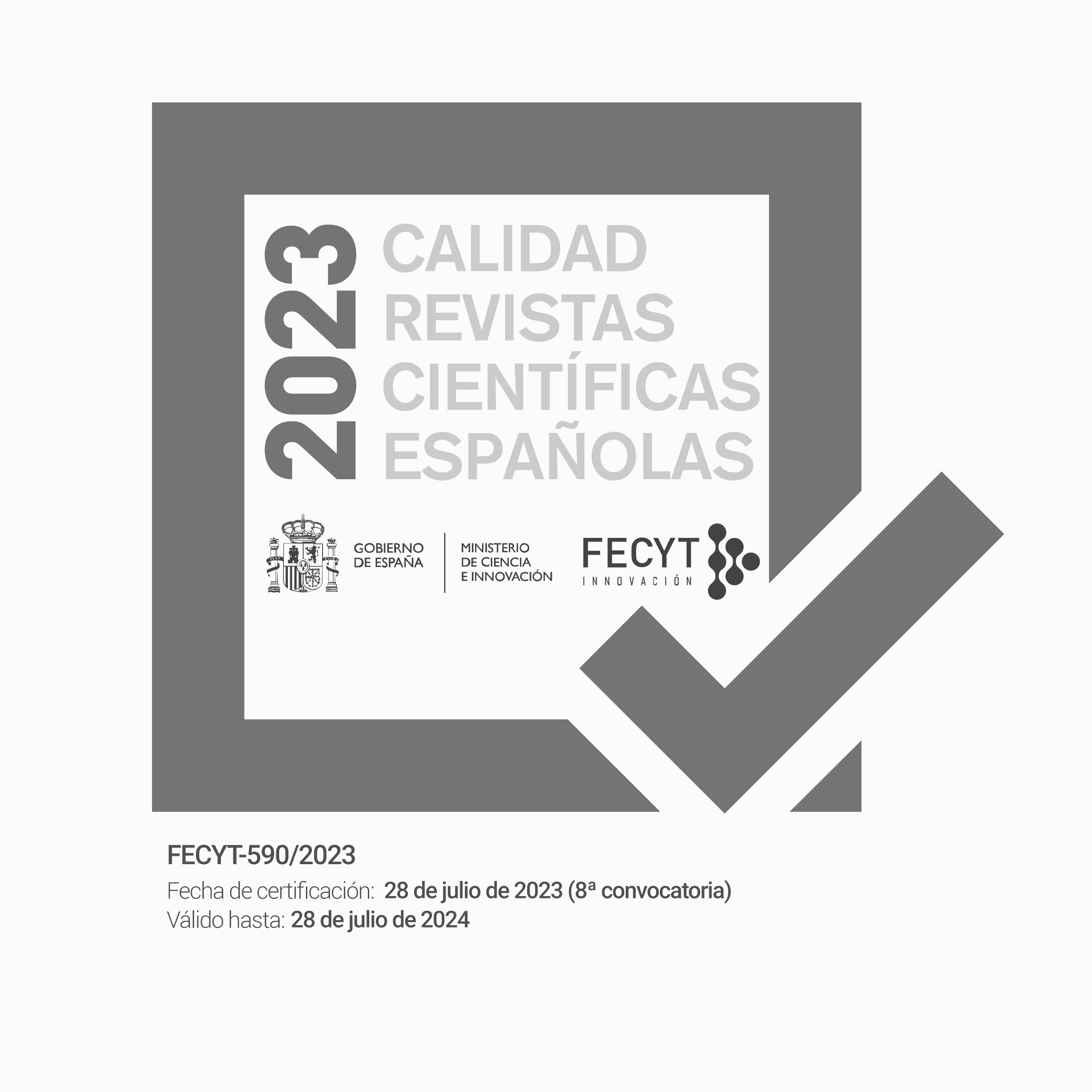Young actresses at work: an analysis of gender and power inequalities in the Italian theatrical sector
Keywords:
gender inequalities, cultural work, theatre actresses, Italy, performing artsAbstract
From the time the ban on women performing in theatrical plays was lifted in mid-1600s England to the communicative impact of the ongoing #MeToo campaign, the presence of actresses on stage has always had
the capacity to profoundly question and significantly reduce societal norms related to gender and cultural spaces. Using a qualitative methodology, this paper analyses young actresses’ experiences of work in the Italian performing arts sector, considering aesthetic and emotional aspects related to theatre work. The occupational environment, described through the sector’s specific datasets and surveys, appears to be characterised by marked power asymmetries in terms of age and gender which, in turn, is embedded in young actresses’ everyday bodily and emotional experiences of work.
Downloads
References
Acker, J. (1992). From Sex Roles to Gendered Institutions. Contemporary Sociology, 21(5), 565. https://doi.
org/10.2307/2075528
Acker, J. (2006). Inequality Regimes. Gender & Society, 20(4), 441–464. https://doi.org/10.1177/0891243206289499
Adkins, L. (1999). Community and Economy: A Retraditionalization of Gender? Theory, Culture & Society, 16(1),
–139. https://doi.org/10.1177/026327699016001008
Alacovska, A. (2018). Informal creative labour practices: A relational work perspective. Human Relations, 71(12),
–1589. https://doi.org/10.1177/0018726718754991
Ambrosetti, E., & Cela, E. (2015). Demography of Race and Ethnicity in Italy. In R. Sáenz, D. G. Embrick, & N. P.
Rodríguez (Eds.), The International Handbook of the Demography of Race and Ethnicity (pp. 457–482). Springer
Netherlands. https://doi.org/10.1007/978-90-481-8891-8_22
Armano, E., & Murgia, A. (2013). The precariousnesses of young knowledge workers: A subject-oriented approach.
Global Discourse, 3(3), 486–501. https://doi.org/10.1080/23269995.2013.865313
Armano, E., & Murgia, A. (2017). Hybrid areas of work in Italy. In Mapping Precariousness, Labour Insecurity and
Uncertain Livelihoods (pp. 47–59). Routledge. https://doi.org/10.4324/9781315593838-5
Arvidsson, A., Malossi, G., & Naro, S. (2010). Passionate Work? Labour Conditions in the Milan Fashion Industry.
Journal for Cultural Research, 14(3), 295–309. https://doi.org/10.1080/14797581003791503
Ashton, D. (2021). Cultural organisations and the emotional labour of becoming entrepreneurial. Poetics. https://
doi.org/10.1016/j.poetic.2021.101534
Bain, A. (2004). Female artistic identity in place: The studio. Social & Cultural Geography, 5(2), 171–193. https://doi.
org/10.1080/14649360410001690204
Banks, M., & Milestone, K. (2011). Individualization, Gender and Cultural Work. Gender, Work & Organization, 18(1),
–89. https://doi.org/10.1111/j.1468-0432.2010.00535.x
Barrios, M., & Villarroya, A. (2021). What is needed to promote gender equality in the cultural sector?
Responses from cultural professionals in Catalonia. European Journal of Cultural Studies, 1–20. https://doi.
org/10.1177/13675494211048903
Bartky, S. Lee. (2015). Femininity and domination: Studies in the phenomenology of oppression. Routledge.
Bataille, P., Casula, C., Bertolini, S., & Perrenoud, M. (2020). From atypical to paradigmatic? Artistic work in
contemporary capitalist societies. Sociologia Del Lavoro, 157(2). https://doi.org/10.13140/RG.2.2.32829.49126
Beck, U. (1992). Risk society: Towards a new modernity (Vol. 17). SAGE Publications Inc.
Bertolini. (2010). Genere e precarietà tra lavoro e famiglia: Percezioni, aspettative e strategie delle giovani donne.
Autonomie locali e servizi sociali, 1, 79–92. https://doi.org/10.1447/32395
Bertolini, S., & Luciano, A. (Eds.). (2011). Incontri dietro le quinte: Imprese e professionisti nel settore dello spettacolo. Il
Mulino. https://www.mulino.it/isbn/9788815150127
Bertolini, S., Moiso, V., & Unt, M. (2019). Precarious and creative: Youth facing uncertainty in the labour market. In
Youth and the Politics of the Present: Coping with Complexity and Ambivalence. Routledge.
Bertolini, S., & Vallero, M. (2011). “Io non faccio la ballerina, io sono una ballerina”. Tra successo e abbandono: I
percorsi di carriera nei settori artistici. Sociologia del lavoro, 123, 207–229. https://doi.org/10.3280/SL2011-123013
Bonomi, A. (2012). Milano: Le tre città che stanno in una. Mondadori.
Bozzon, R. (2008). Modelli di partecipazione delle donne al mercato del lavoro. Un’applicazione dell’analisi delle
sequenze alle storie lavorative femminili. Stato e mercato, 2, 217–250. https://doi.org/10.1425/27523
Bruni, A., Gherardi, S., & Poggio, B. (2004). Doing Gender, Doing Entrepreneurship: An Ethnographic Account
of Intertwined Practices. Gender, Work and Organization, 11(4), 406–429. https://doi.org/10.1111/j.1468-
2004.00240.x
Butler, J. (1990). Gender Trouble: Feminism and the Subversion of Identity. Routledge. https://philpapers.org/rec/BUTGTF
Calbi, A. (Ed.). (2011). Milano. Città e spettacolo. Teatro danza musica cinema e dintorni. Sassi.
Casula, C. (2019). Gender and the Classical Music World: The unaccomplished professionalization of women in
Italy. Per Musi, 39, 1–24. https://doi.org/10.35699/2317-6377.2019.5270
Charmaz, K., & Belgrave, L. (2012). Qualitative interviewing and grounded theory analysis. In J. F. Gubrium, J. A.
Holstein, A. B. Marvasti, & K. D. McKinney (Eds.), The SAGE handbook of interview research: The complexity of
the craft (Vol. 2, pp. 347–365). Sage Thousand Oaks, California.
Colbert, F. (2005). The Piccolo Teatro of Milan: Theatre of Europe. International Journal of Arts Management, 7(3), 66–73.
Comunian, R., & England, L. (2020). Creative and cultural work without filters: Covid-19 and exposed precarity
in the creative economy. Cultural Trends, 29(2), 112–128. https://doi.org/10.1080/09548963.2020.1770577
Conor, B., Gill, R., & Taylor, S. (2015). Gender and Creative Labour. The Sociological Review, 63(1_suppl), 1–22.
https://doi.org/10.1111/1467-954X.12237
Crossley, N. (1996). Body-Subject/Body-Power: Agency, Inscription and Control in Foucault and Merleau-Ponty.
Body & Society, 2(2), 99–116. https://doi.org/10.1177/1357034X96002002006
Csordas, T. J. (1990). Embodiment as a Paradigm for Anthropology. Ethos, 18(1), 5–47. https://doi.org/10.1525/
eth.1990.18.1.02a00010
d’Ovidio, M., & Cossu, A. (2017). Culture is reclaiming the creative city: The case of Macao in Milan, Italy. City,
Culture and Society, 8, 7–12. https://doi.org/10.1016/j.ccs.2016.04.001
Davis, T. C. (2002). Actresses as working women: Their social identity in Victorian culture. Routledge.
Dean, D. (2005). Recruiting a self. Work, Employment and Society, 19(4), 14. https://doi.org/DOI: 10.1177/0950017005058061
Dean, D. (2008). No human resource is an island: Gendered, racialized access to work as a performer. Gender, Work
and Organization, 15(2), 161–181. https://doi.org/10.1111/j.1468-0432.2007.00389.x
Di Nunzio, D., Ferrucci, G., & Toscano, E. (2017). Vita da artisti: Ricerca nazionale sulle condizioni di vita e di lavoro
dei professionisti dello spettacolo. Fondazione Di Vittorio and SLC-CGIL.
Donovan, R. (2019). ‘Must Be Heavyset’: Casting Women, Fat Stigma, and Broadway Bodies. The Journal of American
Drama and Theatre, 31(3). https://academicworks.cuny.edu/gc_pubs/539
Elias, A., Gill, R., & Scharff, C. (2017). Aesthetic Labour: Beauty Politics in Neoliberalism. Palgrave Macmillan UK.
https://doi.org/10.1057/978-1-137-47765-1_1
Entwistle, J., & Wissinger, E. (2006). Keeping up Appearances: Aesthetic Labour in the Fashion Modelling
Industries of London and New York. The Sociological Review, 54(4), 774–794. https://doi.org/10.1111/j.1467-
X.2006.00671.x
Ferrazza, F. (Ed.). (2019). Relazione sull’utilizzazione del Fondo Unico per lo Spettacolo e sull’andamento complessivo dello
spettacolo (p. 284). MiBACT - Ministero per i Beni e le Attività Culturali e per il Turismo.
Florida, R. L. (2002). The rise of the creative class: And how it’s transforming work, leisure, community and everyday life.
Basic Books.
Fraisse, G. (2000). Les deux gouvernements: La famille et la Cité. Gallimard Paris.
Friedman, S., O’Brien, D., & Laurison, D. (2017). ‘Like Skydiving without a Parachute’: How Class Origin Shapes
Occupational Trajectories in British Acting. Sociology, 51(5), 992–1010. https://doi.org/10.1177/0038038516629917
Gallina, M. (2013). Le organizzazioni culturali di fronte alla crisi: Enti teatrali, musicali, di produzione e promozione
d’arte contemporanea e audiovisuale (No. 10; Quaderni dell’osservatorio). Fondazione Cariplo. https://doi.
org/10.4460/2013quaderno10
Gallina, M., Monti, L., & Ponte di Pino, O. (Eds.). (2018). Attore... Ma di lavoro cosa fai? Occupazione, diritti, welfare
nello spettacolo dal vivo. Franco Angeli.
Gandini, A. (2015). Il lavoro freelance: Reputazione e capitale sociale nell’era del “lavoro digitale”. Quaderni Di
Sociologia, 69, 87–106. https://doi.org/10.4000/qds.522
Gherardi, S. (1995). Gender, symbolism and organizational cultures. Sage.
Gill, R. (2002). Cool, Creative and Egalitarian? Exploring Gender in Project-Based New Media Work in Euro.
Information, Communication & Society, 5(1), 70–89. https://doi.org/10.1080/13691180110117668
Gill, R. (2014). Unspeakable Inequalities: Post Feminism, Entrepreneurial Subjectivity, and the Repudiation of
Sexism among Cultural Workers. Social Politics: International Studies in Gender, State & Society, 21(4), 509–528.
https://doi.org/10.1093/sp/jxu016
Goffman, E. (1979). Gender advertisements (1st Harper colophon ed). Harper & Row.
Grindstaff, Laura. (2002). The money shot: Trash, class, and the making of TV talk shows. University of Chicago Press.
Grosz, E. A. (1994). Volatile bodies: Toward a corporeal feminism. Indiana University Press.
Grugulis, I., & Vincent, S. (2009). Whose skill is it anyway?: ‘Soft’ skills and polarization. Work, Employment and
Society, 23(4), 597–615. https://doi.org/10.1177/0950017009344862
Hakim, C. (1991). Grateful slaves and self-made women: Fact and fantasy in women’s work orientations. European
Sociological Review, 7(2), 101–121. https://doi.org/10.1093/oxfordjournals.esr.a036590
Hennekam, S., & Bennett, D. (2017). Sexual Harassment in the Creative Industries: Tolerance, Culture and the Need
for Change: Sexual harassment in the creative industries. Gender, Work & Organization, 24(4), 417–434. https://
doi.org/10.1111/gwao.12176
Hesmondhalgh, D., & Baker, S. (2008). Creative Work and Emotional Labour in the Television Industry. Theory,
Culture & Society, 25(7–8), 97–118. https://doi.org/10.1177/0263276408097798
Hochschild, A. R. (1979). Emotion Work, Feeling Rules, and Social Structure. American Journal of Sociology, 85(3),
–575.
Hochschild, A. R. (1983). The managed heart. University of California Press.
Holla, S. (2016). Justifying Aesthetic Labor: How Fashion Models Enact Coherent Selves. Journal of Contemporary
Ethnography, 45(4), 474–500. https://doi.org/10.1177/0891241615575067
Holla, S. (2020). Food in fashion modelling: Eating as an aesthetic and moral practice. Ethnography, 21(1), 26–47.
https://doi.org/10.1177/1466138118769914
Kessler, S. J., & McKenna, W. (1985). Gender: An ethnomethodological approach. University of Chicago Press.
Locatelli, S. (2015). Teatro Pubblico Servizio? Studi sui primordi del Piccolo Teatro e sul sistema teatrale italiano. lulu.com.
McRobbie, A. (2002). From Holloway to Hollywood: Happiness at Work in the New Cultural Economy? In Cultural
Economy: Cultural Analysis and Commercial Life Cultural economy: Cultural analysis and commercial life (pp. 97–114).
SAGE Publications Ltd. https://doi.org/10.4135/9781446218440.n6
McRobbie, A. (2003). British Fashion Design: Rag Trade or Image Industry? (0 ed.). Routledge. https://doi.
org/10.4324/9780203168011
McRobbie, A. (2009). The aftermath of feminism: Gender, culture and social change. Sage.
Mears, A. (2011). Pricing beauty: The making of a fashion model. University of California Press.
Mears, A., & Connell, C. (2016). The Paradoxical Value of Deviant Cases: Toward a Gendered Theory of Display
Work. Signs: Journal of Women in Culture and Society, 41(2), 333–359. https://doi.org/10.1086/682922
Mears, A., & Finlay, W. (2005). Not Just a Paper Doll: How Models Manage Bodily Capital and Why They Perform
Emotional Labor. Journal of Contemporary Ethnography, 34(3), 317–343. https://doi.org/10.1177/0891241605274559
Menger, P.-M. (1999). Artistic Labor Markets and Careers. Annual Review of Sociology, 25(1), 541–574. https://doi.
org/10.1146/annurev.soc.25.1.541
Murgia, A. (2015). The Obverse and Reverse Sides of Precariousness in Italy: Young highly skilled workers between
passions and skill mismatch. Social Alternatives, 34(4).
Naclerio, E. (2020). Emotional e aesthetic labour nell’esperienza delle attrici di teatro a Milano: Uno studio esplorativo.
In Genere e R-esistenze in movimento: Soggettività, Azioni e prospettive (p. 14). Università di Trento.
Neff, G. (2012). Venture labor: Work and the burden of risk in innovative industries. MIT Press.
Neff, G., Wissinger, E., & Zukin, S. (2005). Entrepreneurial Labor among Cultural Producers: “Cool” Jobs in “Hot”
Industries. Social Semiotics, 15(3), 307–334. https://doi.org/10.1080/10350330500310111
Nickson, D., Warhurst, C., Commander, J., Hurrell, S. A., & Cullen, A. M. (2012). Soft skills and employability: Evidence
from UK retail. Economic and Industrial Democracy, 33(1), 65–84. https://doi.org/10.1177/0143831X11427589
Nochlin, L. (2021). Why have there been no great women artists? Thames & Hudson.
Özkazanç-Pan, B., & Pullen, A. (2020). Gendered labour and work, even in pandemic times. Gender, Work &
Organization, 27(5), 675–676. https://doi.org/10.1111/gwao.12516
Pagnoncelli, N. (2010). Gli immigrati nelle indagini socio-demoscopiche: Un fenomeno sociale ancora largamente
sfuggente. Gli Immigrati Nelle Indagini Socio-Demoscopiche, 1000–1008. https://doi.org/10.3280/LIC2010-003006
Pollock, G. (1999). Differencing the canon: Feminist desire and the writing of art’s histories. Routledge.
Proust, S. (2017). Directeurs artistiques et administratrices: Une distribution sexuée des rôles dans les compagnies
de théâtre indépendantes. Travail, genre et sociétés, n° 38(2), 95. https://doi.org/10.3917/tgs.038.0095
Pullen, K. (2005). Actresses and whores: On stage and in society. Cambridge University Press.
Reyneri, E. (2009). Il lavoro delle donne (pp. 1–47) [Rapporto di ricerca. Il lavoro che cambia. Contributi e raccomandazioni].
Saraceno, C. (1991). Changes in life-course patterns and behavior of three cohorts of Italian women. Signs: Journal
of Women in Culture and Society, 16(3), 502–521.
Saraceno, C. (2002). I paradossi della flessibilità: Una prospettiva di genere e generazionale. In G. Fullin & M. Magatti
(Eds.), Percorsi di lavoro flessibile (Carocci, pp. 220–230).
Scharff, C. (2015). Blowing your own Trumpet: Exploring the Gendered Dynamics of Self-Promotion in the Classical
Music Profession. The Sociological Review, 63(1_suppl), 97–112. https://doi.org/10.1111/1467-954X.12243
Scharff, C. (2016). The Psychic Life of Neoliberalism: Mapping the Contours of Entrepreneurial Subjectivity. Theory,
Culture & Society, 33(6), 107–122. https://doi.org/10.1177/0263276415590164
Scharff, C. (2017). Gender, subjectivity, and cultural work: The classical music profession. Routledge.
Serino, M. (2020). Continuity, change and transitions of artistic professions in the Italian theatre industry”. Sociologia
Del Lavoro, 157, 186–205. https://doi.org/10.3280/SL2020-157010
Simon, S. J. (2019). Hollywood power brokers: Gender and racial inequality in talent agencies. Gender, Work &
Organization, 26(9), 1340–1356. https://doi.org/10.1111/gwao.12365
Skeggs, Beverly. (1997). Formations of Class & Gender: Becoming Respectable. SAGE Publications.
Solera, C. (2012). Corsi di vita femminili tra maternità e lavoro. In M. Naldini, C. Solera, & P. Torrioni (Eds.), Corsi
di vita e generazioni (pp. 87–107). Il Mulino.
Taormina, A. (2006). Il teatro e i suoi pubblici. Economia Della Cultura, 2/2006. https://doi.org/10.1446/22573
Taylor, S., & Littleton, K. (2012). Contemporary identities of creativity and creative work. Ashgate.
Turrini & Chicchi. (2013). Precarious subjectivities are not for sale: The loss of the measurability of labour for
performing arts workers. Global Discourse, 3(3), 507–521. https://doi.org/10.1080/23269995.2014.885167
Wacquant, L. J. D. (1995). Pugs at Work: Bodily Capital and Bodily Labour among Professional Boxers. Body & Society,
(1), 65–93. https://doi.org/10.1177/1357034X95001001005
Warhurst, C., Nickson, D., Witz, A., & Cullen, M. A. (2000). Aesthetic Labour in Interactive Service Work:
Some Case Study Evidence from the ‘New’ Glasgow. The Service Industries Journal, 20(3), 1–18. https://doi.
org/10.1080/02642060000000029
Wittel, A. (2001). Toward a Network Sociality. Theory, Culture & Society, 18(6), 51–76. https://doi.
org/10.1177/026327601018006003
Witz, A., Warhurst, C., & Nickson, D. (2003). The Labour of Aesthetics and the Aesthetics of Organization. Organization,
(1), 33–54. https://doi.org/10.1177/1350508403010001375
Wolf, N. (1991). The beauty myth: How images of beauty are used against women. Random House.
Wolkowitz, C. (2006). Bodies at work. SAGE.
Downloads
Published
How to Cite
Issue
Section
License
Without prejudice to the provisions of article 52 of Spanish Law 22/1987 of November 11 on Intellectual Property, BOE (official state bulletin) of November 17, 1987, and pursuant to said legislation, the author(s) surrender(s) free of charge its rights of edition, publication, distribution and sale of the article, for its publication in Debats. Journal on Culture, Power and Society.
Debats. Journal on Culture, Power and Society is published under the Creative Commons license system in accordance with the «Recognition - Non-Commercial (by-nc) modality: The generation of derivative works is permitted provided that commercial use is not made. Nor can the original work be used for commercial purposes».
Thus, when the author submits his/her contribution, he/she explicitly accepts this assignment of publishing and publishing rights. Authors also authorize Debats. Journal on Culture, Power and Society to include their work in an issue of the journal to be distributed and sold.











